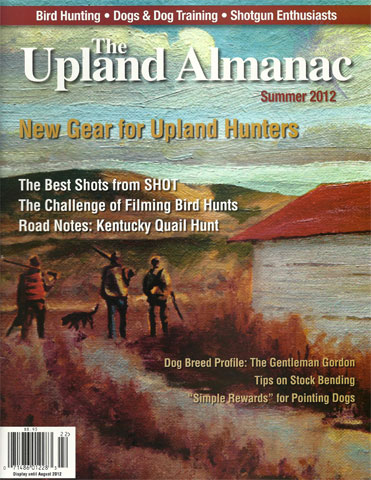Humane Society for Shelter Pets
The National Shooting Sports Foundation reports that Richard Berman has established a group called The Humane Society for Shelter Pets (HSSP). Berman, a longtime opponent of the Humane Society of the United States (HSUS), an anti-hunting group that erroneously claims to support local animal shelters, established his group to counter the efforts of the HSUS. While working at an animal shelter in California, Berman states he tried to enlist the support of the HSUS to put an end to national groups whose TV ads were confusing individual donors who thought their money would be used for their local shelters.
“Instead, the powers that be at HSUS decided to copy the TV ads. So, here I am, years later, still convinced that the confusion needs to be addressed,” Berman says.
The HSSP will work to educate Americans about the need to support local pet shelters as well as address the misperception that national animal charities work locally. The HSSP is a non-profit charitable organization dedicated to fostering a broad base of support for America’s local pet shelters and humane societies.
For more information: www.humaneforpets.com.
Speaking of the HSUS …
In an odd twist of trying to gain control ofAmerica’s stomachs, the Humane Society of the U.S.has purchased stock in the Hardee’s and Carl’s Jr. restaurant chains. It appears the country’s leading animal rights organization purchased the shares to leverage and promote its animal welfare agenda … and again try to force its agenda onto all Americans.
According to a story on the HSUS website, they purchased stock in Apollo Global (Hardee’s parent company) with the hope of forcing CKE Restaurants, operator of the Hardee’s and Carl’s Jr. restaurant chains, to meet HSUS animal treatment standards in its supply chain. There are more than 3,000 Hardee’s and Carl’s Jr. restaurants across America.
HSUS intends to stop Hardees from purchasing eggs from caged hens and pork from systems that confine breeding pigs to gestation crates.
Odd Birds
The Rolling Plains Quail Research Ranch (RPQRR) is asking quail hunters to keep their eyes open for any “weird quail” that may offer clues as to what’s going on with Texas’ quail population.
“We’re asking hunters to report any observations of strange acting quail, or ideally any recent carcasses of sick or dead quail,” says Dr. Dale Rollins, RPQRR’s Director. “Several specimens have been submitted, and these samples may indeed be ‘witnesses to the crime,’ so we’re acutely interested in having such birds examined.”
Hunters who encounter sick quail are asked to contact Dr. Rollins at 325-650-0311, or e-mail him at d-rollins@tamu.edu.
Calling All Women Hunters
The NRA Women on Target Hunt will be held from Oct. 19-21 , 2012, at the Oak Creek Sporting Club in Brainard, Neb. The hunt will be limited to 24 participants for ladies of all levels of experience, with a focus on providing new shooters with a safe and informative experience.
The cost for the event is $350 and includes safety orientation, sporting clays, five-stand, and trap warm-ups; two half-days of hunting for pheasant and chukars; licenses, bird cleaning and packaging; and all meals. What better way to spend a weekend than working pointers and retrievers across 1,500 acres of prime habitat? For more information contact NRA Field Hunt Coordinator Barb Kolodge at Bkolodge627@msn.com or 218-729-5448.
Michiganders to the Rescue
With help from grants received from the Ruffed Grouse Society (RGS), members of the society’s Robert J. Lytle Chapter are embarking on a three-year habitat improvement project that is designed to improve the Deford State Game Area in Tuscola County, Mich.
According to chapter spokesman John Paige, the project seeks to improve the quality of the area’s woodcock singing grounds. “In year one, we propose to mow up to 21.8 acres; in year two, approximately 15.2 acres; and in year three, 22.3 acres. Once cleared, these openings can provide quality singing and roosting habitat for breeding woodcock for years to come if they are mowed on a rotational basis at least every three years.”
The Cass City Field Office of Michigan’s Department of Natural Resources (DNR) is a large proponent of the plan. After the initial mowing, the DNR will work with RGS to maintain the openings. For more information, contact John Paige at jhpaige@chartermi.net.
Both participants in and guides for a recent bird hunt at Primland Lodge in Virginia had a chance to see an intriguing gun in action and to test shoot it if they wanted. Steve Comus, Director of Publications for Safari Club International, unsheathed his 12-gauge French-made Darne shotgun with its unique sliding breech action. In 1897, Regis Darne, a gunsmith from St. Etienne started producing guns with this action. Comus figured his gun was about 100 years old. (Photo/Tailfeather Communications, LLC.)
Strong Holiday Gun Sales Continue Well into the New Year
Reports from around the globe reflect an increase in gun sales. According to USA Today, gun dealers submitted nearly half a million names for background checks in the six days prior to Christmas. From January through November 2011, the FBI processed 14.6 million checks, an increase of 70 percent over 2003 numbers.
According to the National Shooting Sports Foundation (NSSF), 180,000 Americans are employed in the firearms and ammunition industry, which does $4 billion of business per year. Of importance is the fact that contrary to other business sectors that are struggling, the demand for fund has continued growing since 2008.
At the January 2012 Shooting, Hunting, and Outdoor Trade Show (SHOT), overall attendance records were set. NSSF reports more than 61,000 attendees, of which 36,383 were buyers and 2,466 were media, gathered at the Sands Expo and Convention Center in Las Vegas. Industry professionals represented 50 states and 100 countries.
While many hunters and shooters welcome firearms as presents, some critics add a level of caution. “I’m bothered by, especially at the holiday time, how many people think that these things (guns) ought to be holiday gifts, said Toby Hoover, executive direct of the Ohio Coalition Against Gun Violence. “Firearms and weapons don’t seem to go with holidays and peacefulness to me. I think we have a problem.”
“L.L.Bean Bootmobile” Hits the Road in Celebration of 100 Years in the Outdoors
As part of the celebration of its lOOth anniversary, outdoor retailer L.L.Bean introduced the “L.L.Bean Bootmobile” – a larger-than-life embodiment of its most iconic product. The vehicle was revealed to employees at the Brunswick, Maine, manufacturing facility where the popular Bean boots are made, stopping at the L.L.Bean flagship store in Freeport before embarking on a tour of major cities in the U.S. Throughout 2012, the Bootmobile will surprise people in various locations throughout the country, inspiring them to get outside and providing an opportunity to try a new outdoor activity with the help of L.L.Bean’s expert Outdoor Discovery Schools guides.
Leon Leonwood (L.L.) Bean founded his company 100 years ago with a single product, the Maine Hunting Shoe. Having returned from a hunting trip with cold, wet feet, he had a revolutionary idea for a boot design. This innovative “Bean Boot” changed outdoor footwear forever and began one of the most successful family-run businesses in the country. The success of the company is due in part to L.L.Bean’s legendary quality guarantee, which began with L.L.’s first product. Of the first 100 boots be created, 92 were defective, and he refunded the cost to each customer. From there, he went back to the drawing board and re-engineered his boot, which has since stood the rest of time and become the company’s most popular product.
Today, as always, L.L.Bean Boots are manufactured by hand in Maine. In honor of its lOOth anniversary, L.L.Bean will re-introduce a special-edition version of the Maine Hunting Shoe. Designed to closely replicate the very first pair built by L.L., they even feature the red brick-colored bottom found on the original pair.
Recently, the duck boot has become a youthful fashion statement. According to L.L.Bean’s Senior Public Relations Representative Mac McKeever, sales in the past four years have increased from 150,000 pairs per year to about 400,000, with 2012 projections calling for another increase to half a million pairs. “The increase in boot sales has been tremendous,” said McKeever. “We’ve created over 125 new jobs to fulfill the demand, a welcome addition in this challenging economy.”
The newly unveiled Bootmobile is also true in likeness to the original L.L. Bean Boot, yet sports a tan rubber sole found on contemporary versions. The Bootmobile is true to scale, 20.5 times larger that a traditional 12-inch tall boot. A few fun facts about the Bootmobile:
–If the Bootmobile were an actual boot, it would be size 747.
–The Bootmobile is 13 feet tall; 20 feet, 6 inches long; and 7 feet, 6 inches wide.
–The Bootmible generates 0 percent CO2 emissions thanks to a diesel engine with urea tank and particulate filter.
–If an actual person were to wear the Bootmobile, the person would be 143 feet tall, 32 feet taller than the Statue of Liberty.
–The Bootmobile laces are made of 12-strand braided mooring rope, capable of towing 106,000 pounds.
–The driver enters and exits through the heel.
–A camera provides visibility for the rear and top of the Bootmobile.
SportDOG gives back to Sportsmen
SportDOG, a leading manufacturer of remote dog training products, has announced the recipients of five conservation grants totaling $21 ,000. The annual grant program is part of the company’s SportDOG Brand Conservation Fund.
“It’s rewarding to see this program continue to grow,” said Eleanor Marshall, the program’s director. “We’ve seen an increase in the number of applicants for these grants every year. The program generates a tremendous amount of internal support because we believe in supporting conservation initiatives that our employees and customers care about. Over the years, SportDOG has taken part in several great projects, and we look forward to even more in the future.”
The 2011 winners were selected with game birds in mind. The North Dakota Game and Fish Department grant will study sharp-tailed grouse nesting outside of oil and gas development areas in western North Dakota. Down South, the Mississippi Department of Wildlife, Fisheries and Parks will use its funding to assist with the state ‘s prescribed-bum program to improve bobwhite quail habitat. In Iowa, the Marion County Pheasants Forever is in the process of launching a conservation and habitat education program for kids. Delta Waterfowl will support a study of more than 10,000 waterfowl nests for use in future management efforts, and Pheasants Forever will purchase a no-till native grass drill for habitat improvements in North Dakota’s Prairie Pothole region.
To donate to the SportDOG Brand Conservation Fund or to propose a project for grant consideration, visit www.sportdog.com and click on the Conservation Fund in the “About” tab.
This article originally appeared in the Summer 2012 Flushes & Noteworthy Points column of The Upland Almanac.

